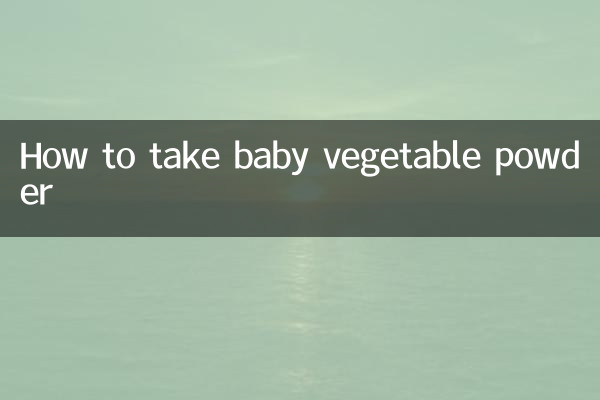How to take baby vegetable powder? Analysis of hot topics on the Internet in the past 10 days
Recently, infant complementary food has become a hot topic in the field of parenting, especially "vegetable powder", a convenient and nutritious form of complementary food that has attracted much attention from parents. This article will combine the hot data of the past 10 days on the Internet to provide you with a detailed analysis of the consumption methods, precautions and purchasing suggestions of baby vegetable powder.
1. Top 5 hot topics on baby food supplements on the Internet (in the past 10 days)

| Ranking | Topic keywords | Search popularity | Main discussion platform |
|---|---|---|---|
| 1 | Baby vegetable powder production | 582,000 | Xiaohongshu/Douyin |
| 2 | Organic food supplement certification | 427,000 | Weibo/Zhihu |
| 3 | Complementary food allergy symptoms | 365,000 | Baby Tree/Mom Network |
| 4 | Vegetable powder nutrition comparison | 298,000 | Douyin/Bilibili |
| 5 | Recommended portable food supplements | 254,000 | E-commerce platform comment area |
2. 5 scientific ways to eat baby vegetable powder
Based on recent interviews with pediatric experts:
| age in months | How to eat | Recommended vegetable powder types | daily dosage |
|---|---|---|---|
| 6-7 months | Mix with rice cereal and eat | Single flavor (pumpkin/carrot) | 1-2 grams |
| 8-9 months | Add to porridge/batter | mixed vegetable powder | 3-5 grams |
| 10-12 months | Making vegetable buns/pancakes | Complete nutritional mixed powder | 5-8 grams |
| 1 year old and above | Bibimbap/soup seasoning | Seasoned vegetable powder | Add appropriate amount |
| special needs | nutritional supplements | Fortified Iron/Calcium Formula | Follow doctor's advice |
3. 4 key points when purchasing baby vegetable powder
Comprehensive e-commerce platform hot-selling product evaluation data:
| index | Premium standards | Risk warning |
|---|---|---|
| raw material | Certified organic + no pesticide residue | Be careful when choosing "farm-made" products without testing |
| Craftsmanship | Low temperature freeze-drying technology | Avoid high-temperature baking to avoid loss of nutrients |
| additive | Zero added sugar/salt/preservatives | Pay attention to the vague labeling of "natural flavoring agents" |
| Package | Light-proof independent small packaging | Large cans are susceptible to moisture and oxidation |
4. The three issues that parents are most concerned about recently
According to statistics from parenting Q&A platforms:
1.Q: Can vegetable powder completely replace fresh vegetables?
A: The latest recommendation from the Chinese Nutrition Society is that vegetable powder should be used as a food supplement, and children over 1 year old still need to consume 50-100g of fresh vegetables every day.
2.Q: Why does homemade vegetable powder turn darker in color?
A: Experts point out that oxidation is the main reason in the home production process. It is recommended to cook and eat it now. Commercial products are more stable due to their antioxidant technology.
3.Q: Which vegetables are not suitable for baby vegetable powder?
A: Recent popular science articles have emphasized that spinach with high oxalic acid content and leafy vegetables with excessive nitrates need to be strictly processed before making.
5. Special reminder from nutritionists
1. Allergic reactions should be observed for 3 consecutive days after the first addition.
2. Nutritional differences among different brands can reach 40%, so it is recommended to replace them regularly.
3. After opening, please keep it refrigerated and use it within 1 month.
4. Combination with oil is more conducive to the absorption of fat-soluble vitamins
The latest industry data shows that the market size of baby vegetable powder will increase by 67% year-on-year in 2023, but the sampling failure rate during the same period is still 8.3%. It is recommended that parents choose products certified by the national standard for infant and young child complementary foods (GB 10769) and keep the proof of purchase.

check the details

check the details